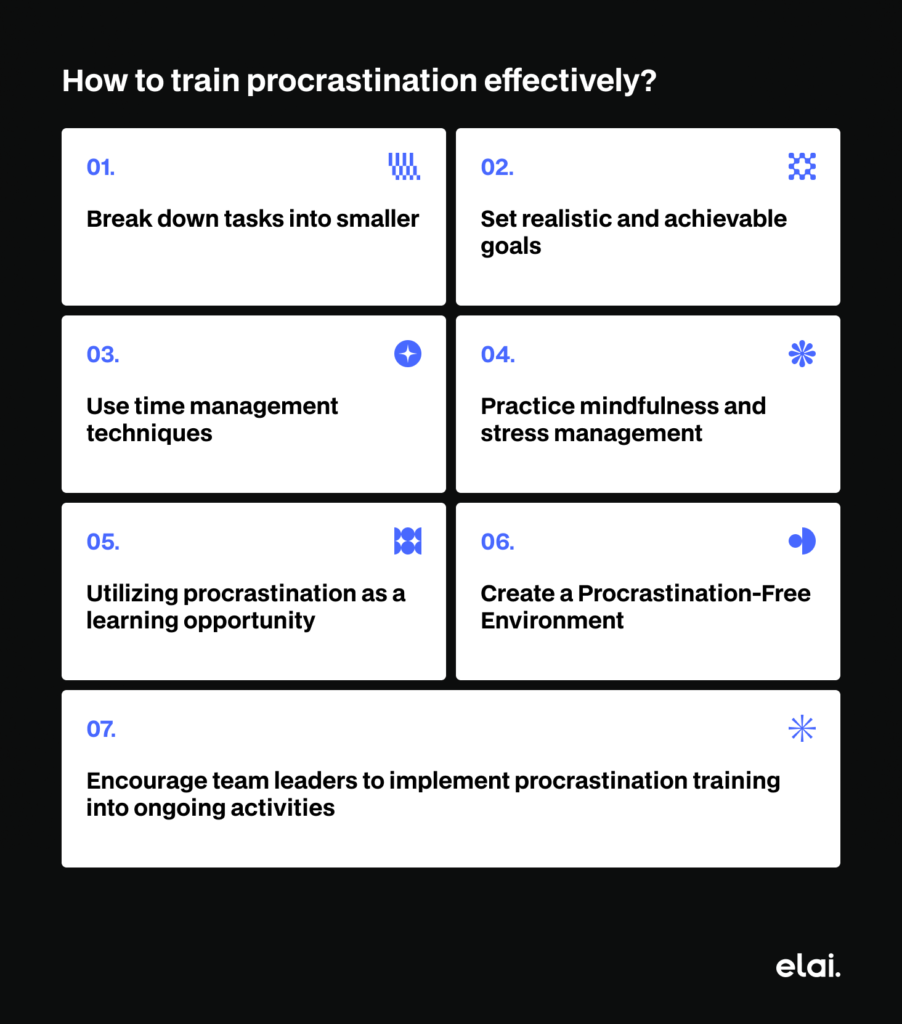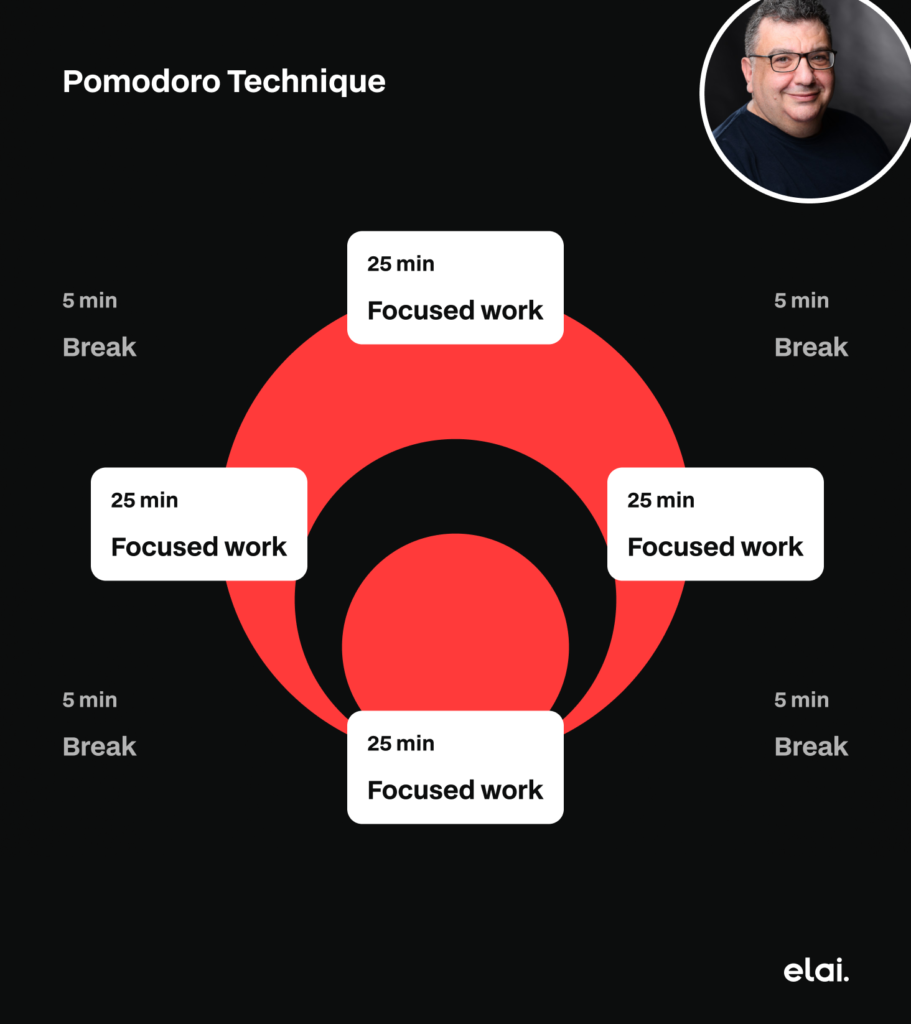Procrastination Training for Overworked L&D Professionals
Inna Horvath2024-09-03T18:25:32+03:00Have you ever postponed an important task, despite knowing that it’s not in one’s best interest? Procrastination is a common “human disease”, however, it can significantly affect overall productivity, stress levels, and an individual’s well-being.
Unfortunately, no one is immune to procrastination even in the field of L&D. The feeling of overwhelm caused by crafting training programs, online mentoring, and following industry learning trends can lead to exhaustion, and delaying tasks. In this article, we will dive deep into the underlying psychology of procrastination and explore useful practices to cope with procrastination-related challenges. Understanding the science behind this act would make it easier to develop new techniques to increase productivity, reduce stress, and ultimately achieve our goals.
Procrastination Among L&D Professionals
Procrastination may also occur in the L&D field when facilitators delay or postpone tasks related to learning and development, despite knowing these tasks are important and need to be completed. This attitude can harm the effectiveness of their L&D initiatives and put professional growth on the brakes.
L&D professionals face lots of stress while trying to prepare and deliver high-quality training programs that can influence the staff and change the direction of the company’s development. Due to the huge amount of responsibility they have to shoulder together with the high demand of their roles, coupled with the pressure of constant influx of new information and technologies, it can be difficult to prioritize and stay focused on specific projects. This is where a good-old procrastination video training comes in. With the help of anti procrastination training, L&D professionals can gain valuable insights into their habits, including time management techniques, goal-setting, and mindfulness practices, and develop effective strategies to overcome this challenge. By implementing this training, L&D professionals will not only enhance their efficiency by reducing stress but also ultimately achieve their professional goals.
Psychological Perspective of Procrastination
From a psychological standpoint, procrastination is often rooted in underlying emotional and cognitive factors. According to the Study by the National Center for Biotechnology Information, around 96.1% of participants experienced academic procrastination at some level which proves a widespread phenomenon among learners. Many participating students had similar symptoms such as:
- Fear of failure or not meeting expectations
- Perfectionism and unattainable standards
- Lack of motivation and interest
- Feeling overwhelmed while facing complex tasks
- Low self-esteem and constant doubt about the ability to succeed
From a medical perspective, such hormones as dopamine and serotonin, key neurotransmitters, influence procrastination. Dopamine, linked to reward and motivation, can lead to impulsivity when excessive. Serotonin, related to mood regulation, indirectly affects procrastination through its impact on emotions. The balance between these neurotransmitters, along with individual factors, plays a significant role in one’s propensity to procrastinate.
Procrastination is often driven by environmental factors such as a disorganized workspace, distractions, unhealthy habits, and unrealistic expectations. Understanding these underlying causes can help individuals develop strategies to overcome procrastination and improve their productivity.
Common Procrastination Patterns in L&D
L&D professionals often suffer from burnout and stress because of all-or-nothing thinking. This pattern involves believing that tasks must be completed perfectly or not at all. Accompanying perfectionism only exacerbates the situation. Imagine an L&D professional who insists on a flawless training program, delaying its launch due to excessive revisions.
Another pattern is catastrophic thinking – the wish to exaggerate the negative consequences of procrastination can create a sense of dread and avoidance. Such behavioral specialty usually results in reduced productivity and low job satisfaction together with the feeling of frustration and guilt. For example, the L&D team is introducing a new online training module. However, they’re concerned that employees might not engage with the content. According to their opinion, unsuccessful training will definitely lead to a productivity crisis, losing clients, staff layoffs, and reputation destruction. Nonsense, isn’t it?
And last but not least – avoidance behaviors. Employees tend to participate in distracting activities to avoid facing the task at hand. Such type of procrastination can affect relationships with colleagues, clients, and stakeholders, resulting in delays and missed deadlines, impacting project timelines and budgets. To illustrate, think of a company introducing a new software platform. Some employees, fearing the unknown or feeling overwhelmed, might avoid learning it by delaying training, minimizing its importance, or even sabotaging learning efforts.
How to train procrastination effectively?
After having explored the main manifestations of procrastination, we can jump to another step – managing this behavior. For L&D professionals, we have outlined the following practices and strategies to employ:
- Break down tasks into smaller, more digestible steps to reduce feelings of overwhelm
- Set realistic and achievable goals to stay motivated and focused and create a reward system for celebrating small and big wins
- Use time management techniques to increase productivity
- Practice mindfulness and stress management to decrease the level of anxiety and develop a growth mindset
- Utilizing procrastination as a learning opportunity
- Create a Procrastination-Free Environment and minimize all distractions
- Encourage team leaders to implement procrastination training into ongoing activities
Now, with the all-in-one video editing platform Elai.io, crafting engaging video content with interactive quizzes and clickable buttons has become faster and even more affordable. 80+ multilingual avatars can explain complex topics in any language. The procrastination video course made with Elai.io is easy to update and rewatch. The ability to add animated illustrations and media boosts learners’ engagement. Moreover, you can export your training courses in SCORM format to any LMS.

Pomodoro Technique: What is this, and how do you use it?
In the late 1980s, Francesco Cirillo developed a time management technique called the “Pomodoro Technique”. This method is based on 25-minute time intervals of focused work broken by five-minute breaks. The research on “Effectiveness of Pomodoro Technique on Memory Retention among Psychology Students in a University in Quezon City” says that short breaks increase productivity and are extremely beneficial for memory. This approach also aids students in better recalling information.

The Benefits of Procrastination Training for Students and Professionals
Anti procrastination training raises awareness of the possible drawbacks of such behavior and offers practical insights on how to manage your productivity under stress and overwhelm. Here are some benefits of implementing procrastination training into your internal courses for employees:
- Improved time management skills. The training can help prioritize tasks and deadlines.
- Increased productivity and efficiency. Learn how to achieve more in less time.
- Enhanced self-discipline and focus. Discover how to develop the ability to resist distractions.
- Reduced stress and anxiety. With proper training, you can cope with procrastination to improve mental well-being.
Conclusion
In this article, we’ve learned what procrastination is and its impact on L&D professionals, discovered the importance of implementing practical strategies to overcome procrastination in the modern workplace, and how to identify this condition in individuals. Procrastination training made with AI can cover all the required knowledge and is easy to share among your colleagues. It not only improves overall team productivity on the way to achieving great company success but also benefits your mental health.
FAQ
How to train yourself to stop procrastinating?
The first step is to diagnose yourself whether you have any procrastination features such as fear of failure, perfectionism, lack of motivation, etc. If so, start creating a Procrastination-Free Environment by minimizing all distractions, then use time management techniques like the Pomodoro Technique to increase productivity, practice mindfulness, and encourage team leaders to implement procrastination training into ongoing activities. Remember to utilize procrastination as a learning opportunity for your personal development.
How to make Procrastination Video Training?
Simply sign up to the Elai.io website, click “Create video”, and write a compelling script and language. Then choose an Avatar and render your project. Share the training with colleagues and Voila!











